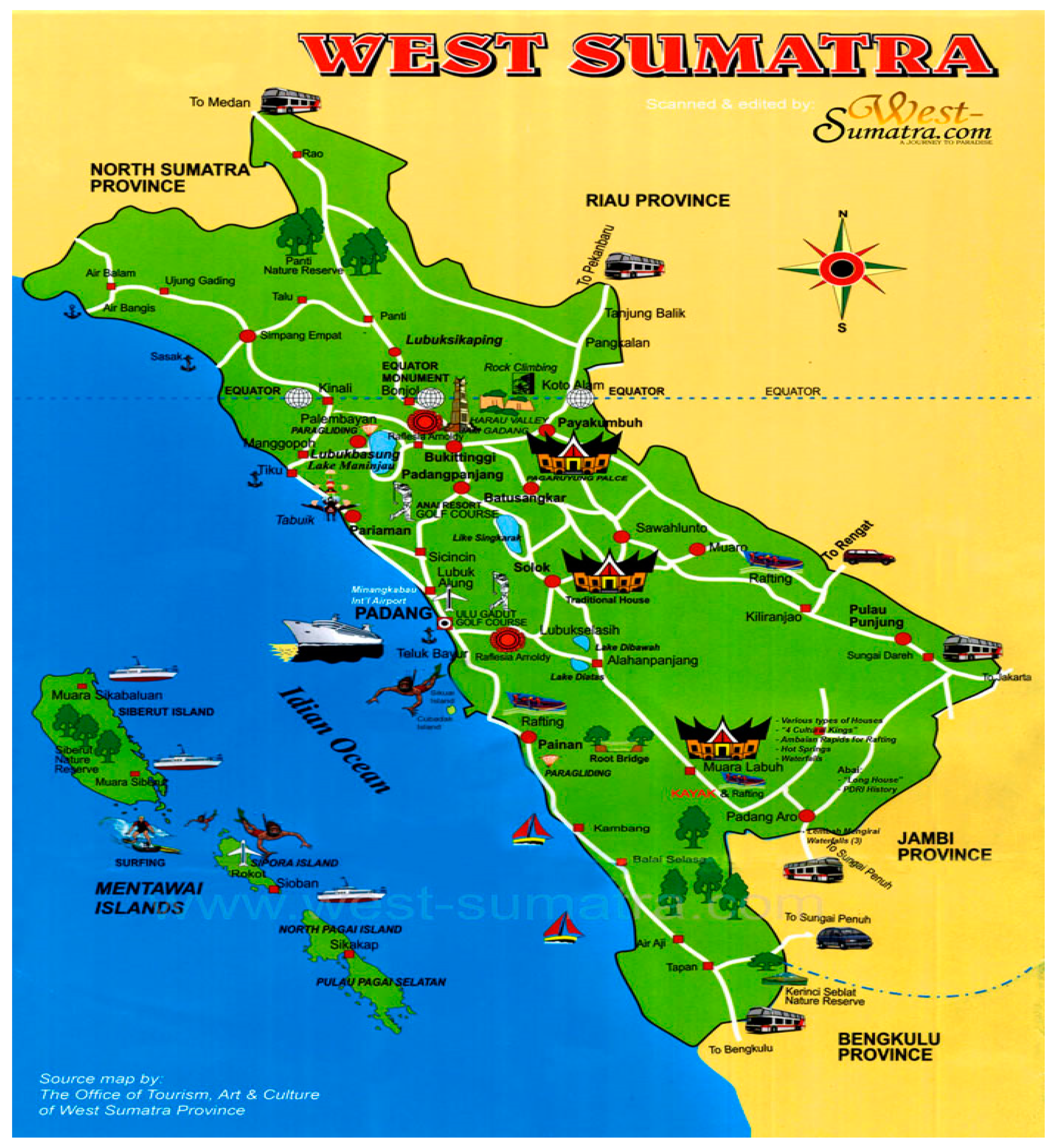Legal Certainty in the Management of Agricultural Land Pawning in the Matrilineal Minangkabau Society, West Sumatra
Abstract
:1. Introduction
2. Materials and Methods
3. Results
3.1. Understanding of Land Pledge and Mortgage
3.2. Agricultural Land Pawning Management in Matrilineal Adat Law
3.3. Agricultural Land Pawning Management in National Law
3.4. Agricultural Land Pawning Management in Islamic Law
4. Discussion
4.1. Legal Certainty in Agricultural Land Pawning
4.2. The Contradiction Between National Law and Adat Law in Agricultural Land Pawning
4.3. Cooperation Between Adat Law and Islamic Law
5. Conclusions
Author Contributions
Funding
Acknowledgments
Conflicts of Interest
Laws and Regulations
Court Verdicts
References
- Tegnan, H. Legal pluralism and land administration in West Sumatra: the implementation of the regulations of both local and nagari governments on communal land tenure. J. Leg. Plur. Unoff. Law 2015, 47, 112–123. [Google Scholar] [CrossRef]
- Nagarajan, G.; Quisumbing, A.; Otsuka, K. Land pawning in the Philippines: An exploration into the consequences of land reform regulations. Dev. Econ. 1991, 29, 125–144. [Google Scholar] [CrossRef]
- Saragih, D. Pengantar Hukum Adat Indonesia; Tarsito: Bandung, Indonesia, 1984; p. 102. [Google Scholar]
- Harsono, B. Undang Undang Pokok Agraria, Sejarah Penyusunan, Isi dan Pelaksanaannya; Djambatan: Jakarta, Indonesia, 1970. [Google Scholar]
- Saragih, D. Pengantar Hukum Adat Indonesia; Tarsito: Bandung, Indonesia, 1982; p. 104. [Google Scholar]
- Yaswirman. Hukum Keluarga, Karakteristik dan Prospek Doktrin Islam dan Adat Dalam Masyarakat Matrilineal Minangkabau; Rajawali Pers: Jakarta, Indonesia, 2011; p. 115. [Google Scholar]
- Schiff, D.N. Socio-legal Theory: Social Structure and Law. Mod. Law Rev. 1975, 39, 287–310. [Google Scholar] [CrossRef]
- Wignyodipuro, S. Pengantar dan Asas-Asas Hukum Adat; Gunung Agung: Jakarta, Indonesia, 1983; pp. 206–212. [Google Scholar]
- Yakub, N. Minangkabau Tanah Pusaka, Buku Ketiga; Pustaka Indonesia: Bukittinggi, Indonesia, 1991; p. 23. [Google Scholar]
- Wiradi, G. Sejarah UUPA-1960 dan Tantangan Pelaksanaannya Selama 44 Tahun. In Proceedings of the FSPI Seminar, Jakarta, Indonesia, 3 September 2004. [Google Scholar]
- Anshori, A.G. Pokok-Pokok Hukum Perjanjian Islam di Indonesia; Citra Media: Yogyakarta, Indonesia, 2006; p. 77. [Google Scholar]
- Rasyid, S. Fiqh Islam; cet. Ke 55; Sinar baru Algensindo: Bandung, Indonesia, 2012; p. 312. [Google Scholar]
- Maxeiner, J.R. Some realism about legal certainty in the globalization of the rule of law. Houst. J. Int. Law 2008, 31, 27–46. [Google Scholar]
- Claes, E.; Devroe, W.; Keirsbilck, B. Facing the Limits of the Law; Springer: Berlin/Heidelberg, Germany, 2009; pp. 92–93. [Google Scholar]
- Leawood, H. Gustav Radbruch: An Extraordinary Legal Philosopher. Wash. Univ. J. Law Policy 2000, 2, 489. [Google Scholar]
- Weiss, U. The Regressive Effect of Legal Uncertainty. J. Disput. Resolut. 2019, 2019, 149–185. [Google Scholar]
- Von Benda-Beckmann, F.; Von Benda-Beckmann, K. Political and Legal Transformations of an Indonesian Polity the Nagari from Colonisation to Decentralisation, 1st ed.; Cambridge University Press: Cambridge, UK, 2013; p. 113. [Google Scholar]
- Arizona, Y.; Cahyadi, E. The Revival of Indigenous Peoples: Contestations over a Special Legislation on Masyarakat Adat; Göttingen Studies in Cultural Property; Göttingen University Press: Göttingen, Germany, 2013; Volume 7. [Google Scholar]
- Putri, D.L. Pelaksanaan Gadai Tanah Pusaka di Sumatera Barat (Studi Kasus di Kanagarian Koto Berapak Kecamatan Bayang Kabupaten Pesisir Selatan). JOM Fak. Huk. 2015, 2, 11. [Google Scholar]
- Warman, K. Hukum Agraria pada Masyarakat Majemuk; Huma: Jakarta, Indonesia, 2010; p. 52. [Google Scholar]

| No | Legal Instruments | Year of Enactment |
|---|---|---|
| 1 | Article 33 section 3 of the 1945 Constitution of the Republic of Indonesia | 1945 |
| 2 | Law No. 5/1960 on the Basic Principles of Agrarian Law | 1960 |
| 3 | Law No. 56 Prp of 1960 on the Determination of Agricultural Land Area | 1960 |
| 4 | West Sumatra Local Regulation No. 16/2008 on Communal Land Tenure | 2008 |
| 5 | Government Regulation No. 224/1961 on Land Reform Objects | 1961 |
| 6 | Government Regulation No. 10/1961 on Complete Village Measurements. | 1961 |
| 7 | Presidential Decree No. 263/1964 on National Land Reform | 1964 |
© 2019 by the authors. Licensee MDPI, Basel, Switzerland. This article is an open access article distributed under the terms and conditions of the Creative Commons Attribution (CC BY) license (http://creativecommons.org/licenses/by/4.0/).
Share and Cite
Nurdin, Z.; Tegnan, H. Legal Certainty in the Management of Agricultural Land Pawning in the Matrilineal Minangkabau Society, West Sumatra. Land 2019, 8, 117. https://doi.org/10.3390/land8080117
Nurdin Z, Tegnan H. Legal Certainty in the Management of Agricultural Land Pawning in the Matrilineal Minangkabau Society, West Sumatra. Land. 2019; 8(8):117. https://doi.org/10.3390/land8080117
Chicago/Turabian StyleNurdin, Zefrizal, and Hilaire Tegnan. 2019. "Legal Certainty in the Management of Agricultural Land Pawning in the Matrilineal Minangkabau Society, West Sumatra" Land 8, no. 8: 117. https://doi.org/10.3390/land8080117





